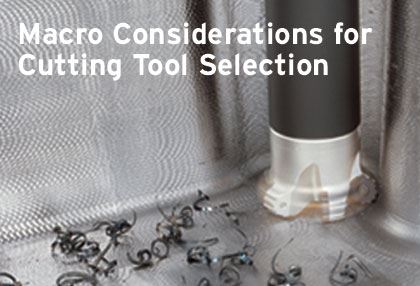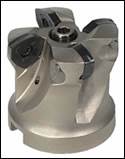Macro Considerations for Cutting Tool Selection
Selecting the best cutting tool is a critical activity to your business success. It’s a re-occurring job that directly impacts cycle time and your shop’s competitiveness.
A typical supermarket has 48,750 Stock Keeping Units and 35 different cans of beans. Now consider that large cutting tool manufacturers each carry more than 40,000 SKUs (like the cans of beans) just in inch sizes! Picking the best can of beans is a piece of cake compared to picking the best cutting tool, just by the numbers alone! Tool selection is about picking tools that fit the machine and cut the part features at the highest quality with the shortest cycle time and at the lowest cost. Here we will review some of the macro considerations in metal cutting tool selection.
The Most Important Tool. If any one tool stops working, production stops. But it does not follow that each tool deserves equal attention. The tool with the longest cut time will have the most influence on cycle time, so all things being equal this tool should command your greatest attention. Give extra attention to the tool that cuts critical part features and the tightest tolerance. Also, tools that are most likely to produce poor chips (e.g., drilling, grooving and threading) deserve more attention. Bad chips cause downtime.
Fit for the Machine. Tools come in hands—right and left—so it’s important to pick the correct hand. Normally right-hand tools fit machines running CCW (as viewed looking into the spindle) and left-hand tools fit machines running CW. If you have several lathes—some that use left-hand tools and others able to use right or left hand—choose left-hand tools. For mills there is a tendency to use a tool with too much reach. While extended-reach tools will cover more parts, you rapidly give up rigidity, increase tool deflection, reduce cutting rates, and they are more likely to chatter. Toolchangers have limits on size and weight. If you paid for coolant thru the spindle, select tools that have this capability.
Fit for the Material. Most machined materials are carbon steel, so most cutting tools are designed to best cut carbon steel. Grade selection is dependent upon the material cut. For nonsteels, tool manufacturers offer lines of toolholders and matching insert geometry designed for these materials—such as high-temperature alloys, titanium, aluminum, composites, plastics and pure metals, etc. If you cut any of these, ask for information about tools designed specifically for those materials.
Size of Tool. A common mistake is selecting a lathe tool that is too small and a mill that is too large. Large lathe tools are more rigid, while larger milling tools are higher priced and spend more time cutting air. In general, larger tools cost more than smaller tools.
Indexable versus Regrindable. This one is simple: avoid grinding tools. With the few exceptions of some drills and end mills, you should select an insertable or indexable design, when offered. You will save labor costs and get more consistent results.
Tool Material and Grades. This is a function of the material you are cutting and the machine’s speed and feed limits. Select the most universal grade for a material class, which will most likely be a coated grade. Use the manufacturer’s grade selection charts. A common mistake is to use a brand grade cross reference chart to solve a tool life problem. If what you have isn’t working and you select the closest like brand you are likely to get similarly poor results. Focus on the mode of failure.
Power Requirements. Here the guiding principle is use what you paid for. If you bought a 20-hp mill, then you should select tools and cutting data that uses 80 percent of the available power, when part and fixtures allow. Pay special attention to the power/rpm charts in the machine owner’s manual. Select tools designed to best cut in the efficient zone of the machine’s power band.
Number of Edges. The rule here is the more, the better. A lathe tool with twice the number of cutting edges normally doesn’t cost twice as much. During the last decade, advances in the design of grooving and cutoff, and some milling inserts, doubled the number of cutting edges per insert. It’s not uncommon to replace an old-design milling cutter having four cutting edges with a modern design having up to 16 cutting edges. The number of effective teeth has a direct effect on table feedrate and productivity.
One Piece Design versus Modular Construction. Small tools are best suited to one-piece designs, while it’s more appropriate to select a modular design for larger tools. For larger tools, when a tool fails you want that part to be the smaller, least expensive part. This is especially true for grooving and boring tools.
Single-Purpose versus Multi-Function. As a general rule, the smaller the part, the more appropriate a multifunction tool is. For example, a single multi-function tool that is able to drill, turn, bore, thread and chamfer. More complex parts are better suited for multi-function tools. A machine makes you money when the tool is in the cut, not when it is being indexed.
Standard or Special. With the introduction of CNC, it was commonly believed that you put the part’s shape in the program, and not in the tool, thus specials were dead. Yet today about 15 percent of high-volume cutting tools are special. Why? Exact size requirements, station reduction and they save time. If you have a large lot size, consider a special tool’s contribution to cycle time reduction. Advances in custom on-demand manufacturing are shrinking the cost and leadtime between standards and specials.
Chip Control. Never forget your aim is to make parts, not chips. Clearly the chip tells how the tool is working, but in general there is too often a preoccupation with the chip. Most people are not trained to read the chip. Focus on the rule: a good chip doesn’t interfere with production and a bad chip does. Inserts are offered with chipbreaker and chipformers designed around the feedrate—from light finishing to heavy roughing. The smaller the chip, the more difficult it is to break. Chip control is more of a problem in ductile materials. You can’t change the material, but you can change your tool selection, speed, feed, depth-of-cut, radius, etc. This is best covered by a discussion on the application at hand.
Programming. Once you have a tool, a part and a CNC machine, you need to define the toolpath. Ideally, you have an understanding of basic machine coding and an advanced CAM package. Toolpath must take into consideration the tool features (e.g., ramp angles, directions of cut, feed and speed). For each kind of metalworking tool there are programming techniques that can shorten cycle time, improve chips and reduce cutting force. A good CAM package is a great labor saver and productivity enhancer.
Latest Innovation versus Commodity Design. At the present pace of advancement, cutting tool productivity doubles about every decade. If you check a 10-year-old cutting tool recommendation, you’ll find today’s tools make chips twice as fast and with 30-percent less power. Newer tools are made from stronger and tougher grades of carbide, and for higher speeds and lower cutting force. Newer tools have chipbreakers and grades that are less application-sensitive and more universal. Newer tools are increasingly multi-function capable and modular—both features reduce inventory requirements while expanding capabilities. Tools have been developed for new approaches to machining—such as plunge and turn tools, high-feed milling tools, high-speed machining, minimum-quantity lubricates and hard turning, etc. For these and other reasons, you need to keep up with the best practices and the latest advancements in cutting tool technology, or you risk obsolescence.
Price. Price is important, but not nearly as important as the cost of the tool. Price is what you pay for the tool. A tool’s true cost is a function of its productivity. Frequently, the most costly tool is the one with the lowest price. The cutting tool’s price as a percentage of a part’s cost, is a mere 3 percent. Focus primarily on a tool’s productivity, not its purchase price.
Field Support. In the U.S. there are about 4,000 factory trained cutting tool specialists. They have the benefit of visiting hundreds of shops, helping many people, and processing many parts in a variety of material and machine combinations. Machining is becoming more of an exact science, yet there is no substitute for experience. As a bonus their services are free and they may even provide tools to test for free. An experienced factory cutting tool specialist is one of your best, and often overlooked aids to tool selection.
In upcoming months we will examine how to choose the best cutting tools for a variety of metalworking applications, digging deeper into unique challenges and common tool selection pitfalls. Future installments will review: turning; external, internal, boring systems, chipbreakers and chipformers milling; indexable face mills, indexable end mills, slotting, solid carbide end mills, thread milling; grooving: OD, ID, face, plunge and turn, threading drilling; solid carbide, small dia. insertable, large dia. indexable, gun drilling, BTA systems; reaming: solid, insertable; toolhoding: standard connection, custom connections; and, special: combination tools, one offs.
Related Content
It Starts With the Part: A Plastic Part Checklist Ensures Good Mold Design
All successful mold build projects start with examining the part to be molded to ensure it is moldable and will meet the customers' production objectives.
Read MoreHands-on Workshop Teaches Mold Maintenance Process
Intensive workshop teaches the process of mold maintenance to help put an end to the firefighting culture of many toolrooms.
Read MoreMoldmakers Deserve a Total Production Solution
Stability, spindle speed and software are essential consideration for your moldmaking machine tool.
Read MoreMaintaining a Wire EDM Machine
To achieve the ultimate capability and level of productivity from your wire EDM on a consistent, repeatable and reliable basis, regular maintenance is a required task.
Read MoreRead Next
Match Cutting Tools To Machine for Maximum Efficiency
A large range of tooling enables moldmakers to match cutting tool to machine and part geometry, resulting in maximum metal removal rates and productivity for roughing applications on conventional and high-speed machining centers.
Read MoreHow to Use Strategic Planning Tools, Data to Manage the Human Side of Business
Q&A with Marion Wells, MMT EAB member and founder of Human Asset Management.
Read MoreReasons to Use Fiber Lasers for Mold Cleaning
Fiber lasers offer a simplicity, speed, control and portability, minimizing mold cleaning risks.
Read More.png;maxWidth=970;quality=90)













.png;maxWidth=300;quality=90)







